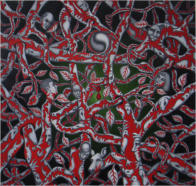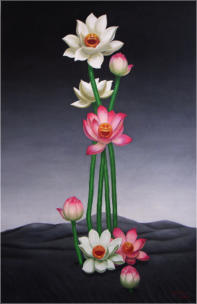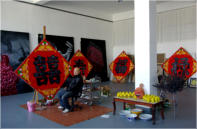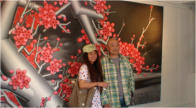HISTORICAL WORKS
SOCIAL
2010 - until now
STATEMENT
Contemporary art addresses contemporary life. After the modernism storm in the early 20th century, contemporary art all over the world is turned to face the social and political. Now contemporary art focuses on environmental problems, national issues, and other pressing subjects. Western academics always want to see real Chinese contemporary art: art which exists neither within the system, nor under the influences of western discourse and commercialism. The hope is to find within the art a truer picture of China, and a variety of thinking from Chinese artists through the collision of tradition and modernity.STATEMENT
But artist QiuChi Chen has refused to turn numb. He swims against the current in the fault zone of culture and spirit, always gazing across the gaps between modern and classic art with international vision, dialoguing with himself, and carefully observing human survival. He uses “the faces” as a symbol to discuss the prospect of human survival, to consider its words. He is an independent thinker, a critic, choosing and creating according to his whim. Throughout this scarring and numbness in society, immunity is tough, and real creation requires a great deal of courage and strength.STATEMENT
Is there justice in the world? How long will the balancing of darkness and light take? How real is the spirit and the power of faith? QiuChi Chen delves deep into the heart of painting to answer these eternal questions. An artist developing a deep concern for his world blooms from a gradual journey of thought and years of practice and understanding. The greatest value of art resides within this concern. Within intellectual history, concern for people is not only the mission of theology, but also constitutes the theme of philosophy. Human care and its own condition is both abstract and representational. Universal love, compassion, pity and help. These embody a kind of humanistic spirit.





2000 - 2009
2010 - present
until 1999
HISTORICAL
WORKS
until 1999
STATEMENT
Contemporary art addresses contemporary life. After the modernism storm in the early 20th century, contemporary art all over the world is turned to face the social and political. Now contemporary art focuses on environmental problems, national issues, and other pressing subjects. Western academics always want to see real Chinese contemporary art: art which exists neither within the system, nor under the influences of western discourse and commercialism. The hope is to find within the art a truer picture of China, and a variety of thinking from Chinese artists through the collision of tradition and modernity.





2000 - 2009
STATEMENT
But artist QiuChi Chen has refused to turn numb. He swims against the current in the fault zone of culture and spirit, always gazing across the gaps between modern and classic art with international vision, dialoguing with himself, and carefully observing human survival. He uses “the faces” as a symbol to discuss the prospect of human survival, to consider its words. He is an independent thinker, a critic, choosing and creating according to his whim. Throughout this scarring and numbness in society, immunity is tough, and real creation requires a great deal of courage and strength.




2010 - present
STATEMENT
Is there justice in the world? How long will the balancing of darkness and light take? How real is the spirit and the power of faith? QiuChi Chen delves deep into the heart of painting to answer these eternal questions. An artist developing a deep concern for his world blooms from a gradual journey of thought and years of practice and understanding. The greatest value of art resides within this concern. Within intellectual history, concern for people is not only the mission of theology, but also constitutes the theme of philosophy. Human care and its own condition is both abstract and representational. Universal love, compassion, pity and help. These embody a kind of humanistic spirit.




SOCIAL





















